The 1995 Federal Shutdown:
A Belated Confession
Above: CNN on then and now
===================================== Photo by PinkMoose, via Flickr

But your blogger sometimes listens to a different drummer. At that time FCC/OET was in a separate building, 2020 M St. that was almost all private tenants and had no FCC security officer. Since no one bothered to change the lock, it was easy to get in if you had a key. I had a health club membership in the same block and came in 2-3 times/week to work out at the health club. (My wife’s agency had an appropriation at that point, so she had to work anyway.)
After working out at the health club, I sneaked into the FCC/OET office space to both ponder the stupidity of the shutdown and also to water everyone’s plants. I figured that people were stressed out enough about the shutdown - it was not clear at that point whether they would eventually get paid - and the last thing they needed was to come back and find that their beloved office plant of x years had died during the shutdown.
Yes, I violated FCC directions and possibly the law. I hope that the statute of limitations has expired. I have no regrets.
2013 Shutdown
Bell Labs Holmdel NJ Landmark Building Saved
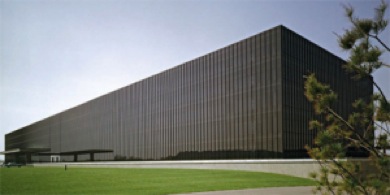
The landmark Eero Saarinen-designed Bell Labs building in Holmdel NJ has been saved from the wrecking ball after having been abandoned by Alcatel-Lucent in 2007. This building is where your blogger started his professional career as an MIT co-op student many years ago. Bob Lucky, former FCC TAC chair has also frequently written about the fate of the building and its significance to the technology community and its neighbors in New Jersey.

The building was completed in 1962 and subsequently expanded in 1966 and 1982 to its final size of two million square feet of office and laboratory space. Around the same time Saarinen designed the IBM Yorktown Heights (NY) Research Center which was similar in many ways although generally used more expensive materials. The rate base-regulated AT&T of the 1960s was more frugal than the unregulated near monopolist IBM of that era.

In 2008, the New Jersey Society of Architects prepared a detailed study/“charette” of the building and preservation/reuse options. But in 2009 the local government appeared to have little interest in preservation. However in August Somerset Development Corp. purchased the property (for $27M). The former research lab that was home to several Nobel laureates will now include a health and wellness center, skilled nursing facility and assisted living center, a hotel, restaurants and shopping, spa, office spaces and a 20,000-square-foot public library. On the surrounding acres, plans call recreational and open space, along with 40 single-family luxury homes and 185 age-restricted town homes. The nearby separate Bell Labs Crawford Hill facility in Holmdel which predated the Saarinen-designed building and was the location of Arno Penzias’ discovery of big bang radiation remains but is reported to have been greatly downsized. It is not architecturally significant although it is historically significant.
Spectrum Lessons from the 2013 Emmys

As NAB engages in arguments with others about how many homes actually watch over-the-air (OTA) television, this week’s Emmy’s demonstrate some of the real problems the TV broadcast establishment is having with their nonspectrum-based competition for the hearts and minds of America.
Consider the outstanding series/program categories of awards:
- Outstanding Comedy Series - Modern Family (ABC)
- Outstanding Drama Series - Breaking Bad (AMC)
- Outstanding Variety Series - The Colbert Report (Comedy Central)
- Outstanding Miniseries or Movie - Behind the Candelabra (HBO)
- Outstanding Reality - Competition Program - The Voice (NBC)
Also consider the outstanding actor/actress awards:
- Outstanding Lead Actor in a Comedy Series - Jim Parsons as Dr. Sheldon Cooper on The Big Bang Theory (Episode: "The Habitation Configuration") (CBS)
- Outstanding Lead Actress in a Comedy Series - Julia Louis-Dreyfus as Selina Meyer on Veep (Episode: "Running") (HBO)
- Outstanding Lead Actor in a Drama Series - Jeff Daniels as Will McAvoy on The Newsroom (Episode: "We Just Decided To") (HBO)
- Outstanding Lead Actress in a Drama Series - Claire Danes as Carrie Mathison on Homeland (Episode: "Q&A") (Showtime)
- Outstanding Lead Actor in a Miniseries or Movie - Michael Douglas as Liberace on Behind the Candelabra (HBO)
- Outstanding Lead Actress in a Miniseries or Movie - Laura Linney as Cathy Jamison on The Big C: Hereafter (Showtime)
Thus in voting by TV industry insiders (not the antibroadcast types at CEA or even CTIA), OTA TV won only 2 out of 5 outstanding program/series awards and only 1 out of 6 outstanding actor/actress awards. Note that HBO alone got more of these awards than ALL of the traditional OTA networks! Sounds like today’s OTA TV is having trouble capturing the audiences it used to get. Maybe it can do better?
Or maybe the whole OTA TV business model is now flawed?
I was interested to read several times that Netflix has outbid its competitors for new popular programming. One reason could be that Netflix has a vast database of user preference information compared to what OTA TV execs have. This allows Netflix to predict the success of new programming better and thus outbid networks and other video providers. GigaOm has written
Netflix didn’t have to spend millions of dollars advertising the new show hoping you would tune in — it knew you’d see it in the recommendations, it knew you’d give it a try and it knew you’d like it.

Together, the major broadcasters account for more than 21 percent of prime-time viewing in the current TV season, down from almost 75 percent in the early 1950s, before cable programmers emerged, according to Nielsen data.
Recently we stayed with a real “millennial” who had 15 Mbps service from Comcast, 2 computers, but no TV and no cable subscription either. For video she relied on Amazon, not the NAB membership. Time will tell how this trend evolves, but it probably should affect spectrum policy decisions in urbanized areas particularly if we can develop mechanisms to replace “free TV’ with universal video service. Actually the National Broadband Plan basically had that but it was too controversial with broadcasters to emphasize.
Pay of Telecom Trade Association Chiefs
Today FierceCable gave us the raw data for CY11.
So here in order are the big three. Sadly for NAB, their man comes in last. Perhaps a sign of the times of the decrease in broadcaster influence in DC. When I joined FCC in 1979, NAB, Motorola,, and AT&T (not the current AT&T) were the big forces at FCC and could almost dictate decisions to the 8th Floor. Only NAB remains of this triumvirate and into longer has the dominant position it once had. (The article reports also that NAB lags in revenue behind CEA, NCTA, CTIA, and even Cable Labs.)
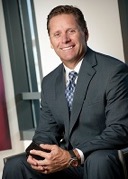
CTIA’s Steve Largent was reported to have “a base salary of $2.3 million and total compensation of $2.7 million in 2011”
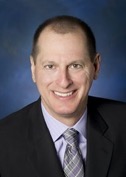
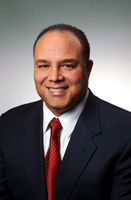
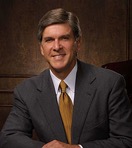
Why is this important? This is not left wing criticism of salary inequality. Rather the reason why these trade associations often stake out extreme positions and are unwilling to seek compromise for timely resolution of spectrum issues is closely related to the high pay of the CEOs and the resulting need of the CEOs to routinely impress the membership with macho stands on contentious issues -- in your blogger’s opinion. When FCC, the “expert agency in spectrum management” tries to seek consensus solutions as the almost universal alternative to deciding an issue on public interest factors, these macho CEOs are a barrier to timely resolution. Technology moves at “Internet speed”. Governments move at “government speed” and in spectrum policy FCC is often moving at the low end of even “government speed”.
As in the case of Docket 10-4 where it took 2487 days to resolve the issue of how to prevent cellular booster interference to cellular systems - not exactly “rocket science” - trade association rigidity to timely compromise hurts all parties involved. The recently announced PCS H block auction is another example of a proceeding that took far too much time to the detriment of the public and most firms involved. (The H Block controversy goes back to at least WT Docket No. 04-356.)
Perhaps FCC should recognize that it must be at least prepared to play King Solomon in technical spectrum disputes if it wants to have timely decisions with these macho players. Consensus solutions are a good idea, but only if they are timely and really equitable.
UPDATE
Here is a table with other trade association CEOs’ salaries for comparison.
CTIA's Love/Hate Relationships with Both SF and Unlicensed
We have written several times about CTIA’s love/hate relationship with unlicensed spectrum and about its generally negative view towards San Francisco - ruling it off limits for any future CTIA meeting and suing it over the city’s attempt to make sure customers have basic information about cell phone safety - information similar to that now available on the website of the Swiss EPA and similar to the text that CTIA’s French counterpart supplies for inclusion with every new cellphone and SIM sold in France.
So imagine your blogger’s surprise when he found this paid content on the Washington Post website:
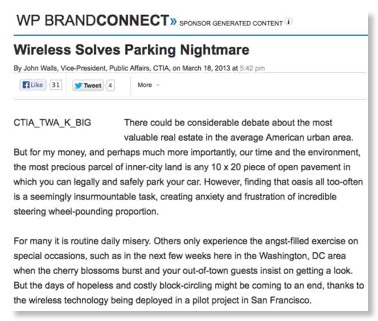
CTIA’s ever quotable John Walls even says
San Francisco’s SF Park initiative uses wireless sensors in city parking spaces and garages to inform city drivers where they can park, thereby reducing congestion, saving time, and lowering greenhouse gas emissions.
Nice words from CTIA about SF!!! Well it certainly is a wireless system and it certainly is in San Francisco, but as we noticed in an April post on CTIA’s boasting about a “wireless” system for farmers, it appears that unlicensed is a key part of the system.
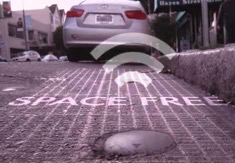
In reality unlicensed and cellular systems have a real synergy. But CTIA endlessly seems to oppose any new unlicensed spectrum and appears to have been the force behind the ill fated “unlicensed auction” House bill that was drafted by a former CTIA staffer.
MS Spectrum Observatory: Seeing Things NTIA Doesn't Want to See
In August 2010 we published a post here entitled “Does NTIA Have the Bureaucratic Courage to Measure Occupancy of 225-400 MHz?” At the time we used the following chart to show bands NTIA had measured and publicly reported on and the middle band they had carefully ignored.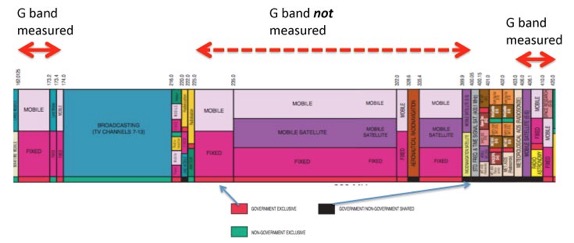
The 225-400 MHz band is home to many federal systems, but is best known for military aircraft communications. In other countries it is used for civilian aircraft communications and in countries where the US has bases, e.g. Japan and NATO countries, there is tenuous sharing. A fact of US geography is that with the notable exception of San Diego there are no large military airfields in major cities. Thus in geography military spectrum use in this band is generally orthogonal to civil needs for spectrum - that is you rarely see a heavy demand for both military aircraft spectrum and civil spectrum users in the same place.
Long time readers may recall that your blogger has been advocating “interruptible spectrum” use here for a long time. Interruptible spectrum is similar to interruptible electricity. One has access to the resource, but can be preempted from time to time when there is great demand for the resource from users with higher priority.
If your view of cellular communications is people calling 911 then this doesn’t make much sense. But all voice communications is a shrinking faction of cellular traffic and 911 traffic must be microscopic. The great growth in demand for mobile broadband is basically for discretionary services, not safety related services. While the cellular community would like to guarantee all users a high quality of service, there frankly isn’t the spectrum available to do so. Other utilities offer pricing schemes to affect demand with approaches like peak pricing in addition to offering interruptible service at a discounted price. The cellular industry just hasn’t been thinking this way.
But similarly NTIA has not been thinking “out of the box” about efficient use of the natural resource at 225-400 MHz despite new White House thinking. The June 14, 2013 Presidential Memorandum -- Expanding America's Leadership in Wireless Innovation stated:
“Although existing efforts will almost double the amount of spectrum available for wireless broadband, we must make available even more spectrum and create new avenues for wireless innovation. One means of doing so is by allowing and encouraging shared access to spectrum that is currently allocated exclusively for Federal use. Where technically and economically feasible, sharing can and should be used to enhance efficiency among all users and expedite commercial access to additional spectrum bands, subject to adequate interference protection for Federal users, especially users with national security, law enforcement, and safety-of-life responsibilities.”
Does 225-400 MHz meet this test of economic and technical feasibility? The lack of official data on its occupancy discourages commercial interest. (Of course the cellular industry’s impossible goal of only getting spectrum that is available 24/7 in all US territory and can use Chinese-made electronics also discourages interest .) There has been some data available in public reports from Shared Spectrum for several years. (See Note 1 below)The following plot was in an early post here.
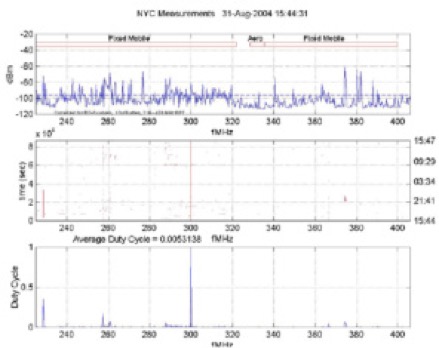
In case the August 2004 date doesn’t ring a bell, this data was taken during the 2004 Republican Convention in New York City 3 years after 9/11 when an unprecedented federal law enforcement and military presence was there to protect national leaders. The third plot shows that spectrum use in 225-400 MHz was negligible despite this high federal presence. Other Shared Spectrum publicly available measurements are at their website and show a similar pattern.
There is also data available from the IIT Spectrum Observatory in Chicago which has been making observations since 2007 and storing them. Unfortunately there is not a simple way for researchers to access this data without making detailed arrangements with IIT.
We recently became aware of another resource, the Microsoft Spectrum Observatory which makes observation between 30 and 6,000 MHz in Brussels, Redmond, Seattle, and Washington DC. Unlike the IIT measurements, these are available for online access to anyone!
So how busy is 225-400 MHz in Washington DC and Seattle? In the 2 charts below I picked for the whole day of 1/21/13 in DC, the day of President Obama’s second inauguration and an exceptionally high federal presence. In the case of Seattle I picked 6/4/13, a day I happened to have been there for a conference which I recall was a bright warm sunny day unlike what one expects in Seattle.
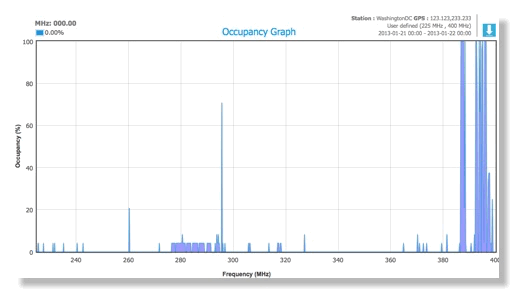
Spectrum Occupancy Washington DC 1/21/13 24 hour data (225-400 MHz)
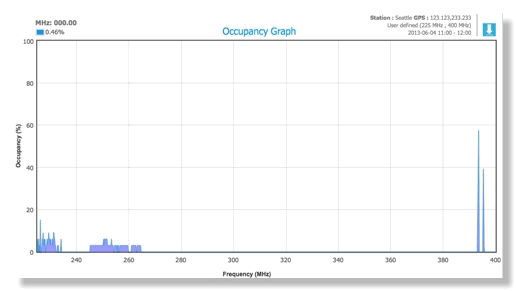
Spectrum Occupancy Seattle WA 6/4/13 1100-1200 (225-400 MHz)
So the cellular industry is not interested in this band because it wants 24/7 nationwide access and the ability to use Chinese-made electronics that meet global standards. Why isn’t FCC and NTIA interested? Repeatedly the problem I hear is that it would complicate the job for DoD spectrum managers stationed overseas who have to explain to our allies why dedicated military channels are needed in this band. The fear is that if DoD doesn’t need 24/7 access to this band in the US, why do they need access in Japan and Europe? This is a real issue but I think it is time to stop holding US spectrum use hostage in order to simplify the job of DoD spectrum managers overseas. The issue here is not reallocating this spectrum to 24/7 commercial use and not using it for 5GHz-like “dynamic spectrum access” that depends on sensing, but rather have a dynamic database system that updates cellular base station in real time which frequencies can be used on a fail-safe basis. Normally base station would have access to much of the band, but as military traffic start building up in an area, blocks would be cleared in anticipation of more traffic so the military traffic would always have what it need plus an additional block of spectrum for rapid surges.

Note 1: There is no detailed generally accepted way to measure occupancy so it is impossible to make precise comparison of measurements. Many decisions have to be made before data is collected and those decisions affect the numbers. Some possible decisions increase apparent occupancy, some decision decrease it. I vividly recall climbing Mt. Fuji in Japan about 15 years ago with my trusty 2m amateur radio. At the top of 12,388' (3,776 m) Mt. Fuji all amateur radio frequencies in the 2m band are fully occupied since the radio horizon includes most of the main island of Honshu! Similarly sensitivity/noise figure, filtering, and 3rd order intercept point decisions affect apparent occupancy. But that said, measurements with very low occupancy show that there is a real issue that should be investigated to confirm or deny whether spectrum is available. Note also that spectrum occupancy measurements usually miss satellite uplink and some downlink transmissions due to their nature. Measurements of full duplex bands with base stations also tend to see the base station downlinks and due to siting can miss the corresponding uplink traffic.
Note 2: How might 225-400 be shared with the private sector? It is clear that any use mobile-based spectrum sharing decision system is not secure enough for the national security uses of this band. Also no listen-before-talk (LBT) cognitive radio system would be reliable enough either. But a base station-based system, typical in today’s cellular systems would place the spectrum selection system in the hands of a few carriers. The carrier spectrum election system could then in turn be controlled in a fail/safe way by DoD spectrum managers to make sure that at a given moment the spectrum is adequate to handle at least (100 + x)% of the authorized DoD traffic. As the DoD traffic approaches the amount set aside for them at a given time in a given area the amount set aside should be increased to maintain a positive margin of available spectrum above demand. Some may argue that the physics of this sharing is similar to the 1755-1850 MHz sharing considered by NTIA’s CSMAC. The D/U ratios discussed there were computed using a primitive propagation that IRAC prefers because it is very conservative. A more balanced consideration of sharing issues under the terms of the 6/13 Presidential Memo would likely give differing answers.
UPDATE
See http://www.marcus-spectrum.com/Blog/files/SpecMeasCorr414.html
Wi-Fi on Airlines: Honeywell Survey Finds Huge Demand

The Today show today included a tidbit about a recent Honeywell Aerospace-sponsored survey on the public’s view of Wi-Fi on airplanes. No doubt Honeywell is a provider of the equipment for this connectivity so a poll sponsored by them might have some biases like the previously mentioned polls by CEA and NAB on home use of over the air (OTA) TV. But the graphic shown at the top was truly fascinating!
In a press release and a paragraph entitled “Comfort Redefined” Honeywell wrote:
For most travelers, the current commercial flight experience can be summarized in one word: crowded. Crowded flights and cramped seats have become the norm. According to the Honeywell survey, however, almost 90 percent of fliers would give up an amenity on their flight — preferred seats, extra legroom and more — to be guaranteed a faster and more consistent wireless connection. This finding potentially alters how passengers define comfort on flights. The survey indicated:
More than one-third of Americans and Singaporeans and nearly half of Britons who would give up an amenity would give up a preferred seat for a better Internet connection.
Almost two-thirds of passengers would rather have access to fast in-flight Wi-Fi that allows them to stream video and music than sit in their preferred seat.More Connections, Please
More than three in four fliers surveyed think wireless access should always be available on planes. And when it comes to the current in-flight Wi-Fi experience, passengers want the type of consistency and speed experienced at home or in the office, especially on transoceanic or international flights.
In-flight Wi-Fi service causes frustrations for nearly nine in ten users worldwide. Inconsistent or slow connections disappoint fliers most.
More than one-third of passengers surveyed would be disappointed if in-flight Wi-Fi was not available on an international flight or over an ocean.
Now we know that cell phone use and Wi-Fi are cross elastic with the right hardware and Skype software. But if the Honeywell survey is even vaguely correct, it is amazing what a resonance Wi-Fi use in aircraft has hit!
1985 FCC Approval of Band that is the Home of Wi-Fi
How Many Homes Really Watch Over the Air TV?
New NAB/CEA Feud
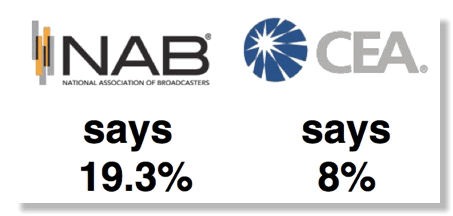
They can’t both be right!
Remember a few years ago when CEA and NAB were cooperating in 2008-9 with each other to facilitate the DTV transition? Wasn’t that nice? Two industries sharing their toys like nice little children. Only a little earlier in 2005 they were accusing each other of things like “Perpetuating a Fraud on Consumers”. Well, they are back at each others’ throats again! The telecom bloggers of the USA thank both for this gift. Now that Jon Stewart is back, we hope he can benefit from it also.
On June 21, 2013 NAB announced that
New research from GfK Media & Entertainment shows that the estimated number of Americans now relying exclusively on over-the-air (OTA) television broadcasting increased to 59.7 million, up from 54 million just a year ago. The percentage of TV households currently OTA reliant has now grown from 14% in 2010 to 19.3% in the current survey, a 38% increase in just four years. The recently completed survey also found that the demographics of broadcast-only households continue to skew toward younger adults, minorities and lower-income families.

We're one of the world’s leading research companies. Every day, our 12,000+ experts discover new insights into the way people live, think and shop in over 100 countries. We use the latest technologies and smartest methodologies to help our clients deeply understand the most important people in the world: their customers.
Sounds a lot more credible than some blogger, doesn’t it?
But then only 9 days later, NAB’s former partner in DTV transition, CEA, announced
The CEA report was designed and formulated by CEA Market Research, “the most comprehensive source of sales data, forecasts, consumer research and historical trends for the consumer electronics industry” with “90+ years of research history” - GfK is only 79 years old, founded in Nuremberg, Germany in 1934. (Perhaps it isn’t fair to say so, but Leni Riefenstahl’s Triumph of the Will was filmed in Nuremberg in 1934 -- in case the date and location sound familiar. “By general consent [one] of the best documentaries ever made.” -- Roger Ebert)New research released today from the Consumer Electronics Association (CEA) ® found that just seven percent of American TV households rely solely on an antenna for their television programming. The findings of the new study, U.S. Household Television Usage Update, are consistent with CEA’s 2010 research which found eight percent of TV households reported using an antenna only for television programming. According to historical CEA research, there has been a gradual decline in the percentage of TV households using antennas since 2005. The phone survey of 1,009 U.S. adults is comparable to a 2012 Nielsen study indicating nine percent of all U.S. TV households are broadcast TV/over-the-air only, a decrease from 16 percent in 2003.
The only publicly available details on the study cited by NAB in an entry in the GfK blog entitled “Confessions of a Cord Cutter Skeptic Revisited”. By contrast, CEA would be glad to sell you a copy of their whole study ($399 if costs matter, no cost to CEA members).
But the issue here is critical to the pending incentive auction and the whole question of the spectrum needs of TV broadcasting. So this is too important a question to leave to CEA/NAB finger pointing! So in the interest of closure on this issue here is:
A Suggestion to Resolve This Key Disagreement: For at least 2 decades FCC has been paying Census Bureau for quarterly telephone penetration surveys which have been noncontroversial since Census is viewed by all as unbiased on this issue. This data collection is now part of the he Current Population Survey (CPS), sponsored jointly by the U.S. Census Bureau and the U.S. Bureau of Labor Statistics (BLS). Just last Thursday, WSJ reported on the the latest survey and found that “more than a quarter of U.S. households have ditched landline phones”. Significant changes in consumer behavior result from pricing changes and technology changes.
Since the issue of OTA market share is critical for the incentive auction, why doesn’t FCC pay Census to track both OTA home penetration as well as telephone penetration? I suspect that the cost would be allowable as part of the expenditures to support the incentive auctions and thus need not come from the very limited FCC appropriated budget.
Ronald Coase, 1920-2013, R.I.P.
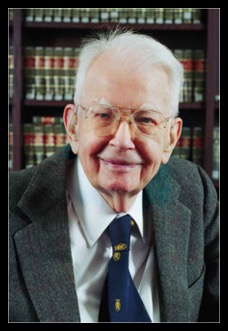
Prof. Ronald Coase died Monday September 2 after a brief illness at age 102. He was the oldest living Nobel Prize winner. He was awarded the Nobel Prize in Economics in 1991. He was famous for 2 pioneering papers that The NY Times describes as follows:
- In one, “The Nature of the Firm,” which was largely developed while he was still an undergraduate and published in 1937, Professor Coase revolutionized economists’ understanding of why people create companies and what determines their size and scope. He introduced the concept of transaction costs — the costs each party incurs in the course of buying or selling things — and showed that companies made economic sense when they were able to reduce or eliminate those costs by performing some functions in-house rather than dealing in the marketplace.
- In the second of his groundbreaking papers, “The Problem of Social Cost,” published in 1960, Professor Coase challenged the idea that the only way to restrain people and companies from behaving in ways that harmed others was through government intervention. He argued that if there were no transaction costs, the affected parties could negotiate and settle conflicts privately to their mutual benefit, and that fostering such settlements might make more economic sense than pre-empting them with regulations. The paper made the idea of property rights fundamental to understanding the role of regulation in the economy. It grew out of a study by Professor Coase of how the Federal Communications Commission licensed broadcasters.
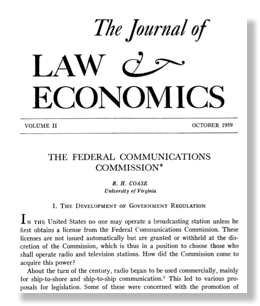
In memory of Prof. Coase, here is a brief quote from that paper:
V. PRIVATE PROPERTY AND THE ALLOCATION OF FREQUENCIES
If the right to use a frequency is to be sold, the nature of that right would have to be precisely defined. A simple answer would be to leave the situation essentially as it is now: the broadcaster would buy the right to use, for a certain period, an assigned frequency to transmit signals at a given power for certain hours from a transmitter located in a particular place. This would simply superimpose a payment on to the present system. It would certainly make it possible for the person or firm who is to use a frequency to be determined in the market. But the enforcement of such detailed regulations for the operation of stations as are now imposed by the Federal Communications Commission would severely limit the extent to which the way the frequency was used could be determined by the forces of the market.
It might be argued that this is by no means an unusual situation, since the rights acquired when one buys, say, a piece of land, are determined not by the forces of supply and demand but by the law of property in land. But this is by no means the whole truth. Whether a newly discovered cave belongs to the man who discovered it, the man on whose land the entrance to the cave is located, or the man who owns the surface under which the cave is situated is no doubt dependent on the law of property. But the law merely determines the person with whom it is necessary to make a contract to obtain the use of the cave. Whether the cave is used for storing bank records, as a natural gas reservoir,or for growing mushrooms depends,not on the law of property,but on whether the bank, the natural gas corporation,or the mushroom concern will pay the most in order to be able to use the cave. One of the purposes of the legal system is to establish that clear delimitation of rights on the basis of which the transfer and recombination of rights can take place through the market. In the case of radio, it should be possible for someone who is granted the use of a frequency to arrange to share it with someone else, with what- ever adjustments to hours of operation,power, location and kind of transmitter, etc., as may be mutually agreed upon; or when the right initially acquire is the shared use of a frequency (and in certain cases the FCC has permitted only shared usage), it should not be made impossible for one user to buy out the rights of the other users so as to obtain an exclusive usage.
Obits & Tributes:
Wall Street Journal
- Ronald Coase, Author of 'Most-Cited Law Review Article,' Dead at 102
- Economist's Theories Led to Carbon Trading
- Review & Outlook: The Wisdom of Ronald Coase
- The Man Who Resisted 'Blackboard Economics'
New York Times
- Ronald H. Coase, a Law Professor and Leading Economist, Dies at 102
- Economic View: Of Individual Liberty and Cap and Trade
Washington Post
The Societal Cost of Unrestricted Sale of Burner Phones
However, if at the same Walmart you want to buy Sudafed you will find that the law allows for the sale of pseudoephedrine only from locked cabinets or behind the counter. The law also:
- limits the monthly amount any individual could purchase
- requires individuals to present photo identification to purchase such medications
- requires retailers to keep personal information about these customers for at least two years after the purchase of these medicines.
As we wrote last month, CVS is voluntarily beginning to limit - not forbid - sales of nail polish remover because the acetone in it is also key to the crystal meth production process. However there is no sign that they are limiting sales of “burner” phones.
In its reply comments to Docket 13-111 on wireless devices in prisons, Verizon Wireless commented on “brier” phone restriction issue. This is the first time we are aware that CTIA or any of its major members has publicly addressed the feasibility of restricting sales of “burner” phones. VZW told FCC:
One commenter suggested that the Commission consider placing requirements on the type of information and the validity of information carriers obtain in providing service to customers purchasing prepaid devices. MSS Comments at 13-14. See also Indiana Department of Corrections Comments, GN Docket No. 13-111, filed July 17, 2013 (“Indiana DOC Comments”) at 1 (questioning whether selling such devices to anonymous persons is desirable public policy). While MSS acknowledges the legitimate need of some users, such as battered spouses, to obtain such devices anonymously, it urges the Commission to consider requiring identification validation for at least some purchasers of prepaid devices. Given that such a requirement would necessarily impact users other than contraband device users, this suggestion is beyond the scope of this proceeding and should not be considered in this docket.
So VZW feels that since restrictions might impact some legitimate users, we should not even think about restrictions that may have a balance of pluses and minuses. As can be seen in the picture at right, VZW at one time even used vending machines to sell “burner” phones! If Congress had similarly thought that the need of the public to buy Sudafed outweighed the benefits of preventing deaths through methamphetamine abuse, then we would not have the “burdens” we face in buying Sudafed today. Had only the Sudafed makers been represented by CTIA we might be able to find Sudafed vending machines on street corners for the convenience of those with a late night case of a runny nose!
But a September 1 NY Times article entitled “Drug Agents Use Vast Phone Trove, Eclipsing N.S.A.’s” reveals another cost of the unrestricted sale of burner phones. The article describes how AT&T sells to DEA access to “Hemisphere” - a huge database of “metadata” about the phone calls of Americans. As opposed to the NSA database, Hemisphere “covers every call that passes through an AT&T switch — not just those made by AT&T customers — and includes calls dating back 26 years”.
Why does DEA needs such a comprehensive, and no doubt costly system? The article goes on to say:
The Obama administration acknowledged the extraordinary scale of the Hemisphere database and the unusual embedding of AT&T employees in government drug units in three states.But they said the project, which has proved especially useful in finding criminals who discard cellphones frequently to thwart government tracking, employed routine investigative procedures used in criminal cases for decades and posed no novel privacy issues. (Emphasis added.)
Thus because the cellular industry is not willing to consider any compromise to the unrestricted sale of “burner” phones we must live with a large invasion of privacy by DEA and its state and local partners and the potential abuse of this information. It appears that AT&T has even turned this into a new secret, but presumably profitable, product line!
Wouldn’t modest regulations on “burner” phone sales, perhaps similar to the above stated DEA rules on Sudafed sales, be a more reasonable balance of public interests? If there is ever a cell phone triggered IED incident in the US, there will be a large outcry for such regulation and the outcome will not be as moderate and balanced as what would be feasible today in a less frantic atmosphere. We urge the initiation of a deliberate dialogue on this topic to balance all legitimate needs. Do we really need unrestricted sales of bags full of anonymous prepaid “burner” phones?

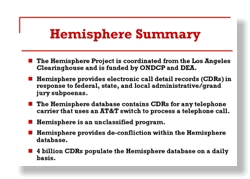


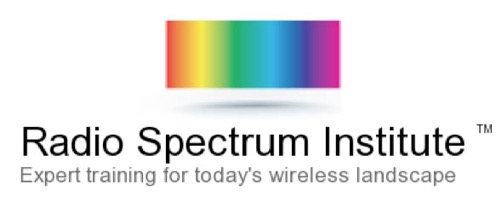


![Validate my RSS feed [Valid RSS]](valid-rss-rogers.png)

